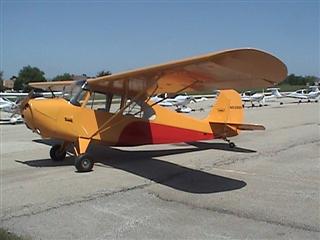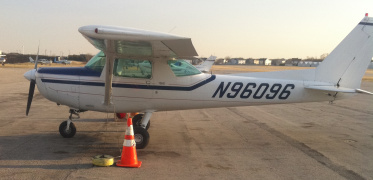Aeronca Champ
 We have a 1946 Aeronca Champion 7AC ("Champ") available! This is a tailwheel airplane, also known as "conventional gear", and seats two in a tandem (fore and aft) configuration. This uses a center stick instead of a yoke, and is currently unique in the fleet as it is a Sport Pilot-qualified airplane. This means that it is possible to fly this with only a Sport Pilot certificate. This airplane doesn't have an electrical system, so it is started by hand-propping. Don't worry, you'll get instruction in it before you do it on your own!
We have a 1946 Aeronca Champion 7AC ("Champ") available! This is a tailwheel airplane, also known as "conventional gear", and seats two in a tandem (fore and aft) configuration. This uses a center stick instead of a yoke, and is currently unique in the fleet as it is a Sport Pilot-qualified airplane. This means that it is possible to fly this with only a Sport Pilot certificate. This airplane doesn't have an electrical system, so it is started by hand-propping. Don't worry, you'll get instruction in it before you do it on your own!
For more information, see the Wikipedia article on the Aeronca Champ.
Cessna 152
We have two Cessna 152s, known affectionately known as the "Batmobile" (a 1978 model that has graduated more private pilots than any other plane at A&M) and "Batmobile II" (a 1986 model)! They both have an intercom and GPS, while N96096 is IFR certified.
For more information, see the Wikipedia article on the Cessna 152.

Specifications
| Champ | C152 | |
| Places | 2 | |
| Useful Load | 426.5 lbs | 491 - 519 lbs |
| Cruise speed | 80 KTS | 107 KTS |
| Fuel burn (typical) | 4.0gph | 6.1 gph |
| Usable Fuel capacity | 12 gal | 24.5 gal |
| Ceiling | 12,400 | 14,700 |
| Range | 240NM | 320NM |
| Avionics | portable intercom portable radio |
VFR GPS (N96009) |
| Tail | Type | Empty Weight | Gross Weight | Empty Moment |
| N82889 | Champ | 793.5 | 1220 | 12.730 |
| N69009 | 152 | 1150.63 | 1670 | 34.3960 |
| N96096 | 152 | 1178.85 | 1670 | 34.7425 |
Disclaimer: These values for comparison only and are not to be considered official numbers. It is the Pilot in Command's responsibility to verify any numbers used in calculating performance against official numbers found in the airplane's Operating Handbook.

